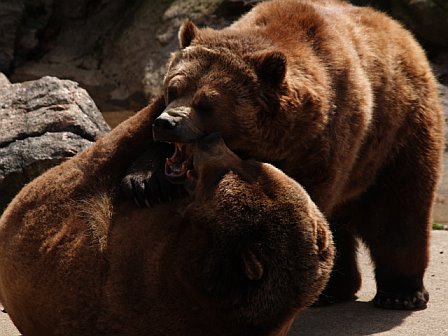
Two Grizzly Bears playing at the Bronx Zoo. One of the bears, Jughead (all the Bronx grizzlies are named after “Archie” characters) died earlier this year.

Two Grizzly Bears playing at the Bronx Zoo. One of the bears, Jughead (all the Bronx grizzlies are named after “Archie” characters) died earlier this year.
Here’s the last set of the photos from this past weekend, and as soon as I get the entire set uploaded to Flickr I’ll let you all know.

One of the gorillas at the Primate House. I only saw two while I was at the zoo, so I assume that most of the rest of them were inside or in an area out of view.

A Grevy’s Zebra (Equus grevyi).

A Prairie Dog (Cynomys sp.) having a snack.

The only visible “enrichment” the African Elephants had was a naked metal chain, and the elephant that I was told was named “Petunia” couldn’t stop fiddling with it. I have to wonder if some of this was a way to comfort herself or divert unease, as just before this picture she was driven out of the shade by the two other elephants she shared her habitat with, and overall she seemed to be restless/ill at ease the entire day.

This is “Puzzles,” the Reticulated Giraffe (Giraffa camelopardalis reticulata). I don’t know why the zoo staff has not operated on this animal, and the plaque outside the enclosure is a bit shore on details. Perhaps the condition is inoperable, and it doesn’t seem to visibly inhibit the giraffe, but I do feel sympathy for Puzzles.

The most deadly of all creatures, the Pygmy Marmost [Callithrix (Cebuella) pygmaea]. Don’t let their cute appearance fool you; they can deskeletonize a cow in seconds… or is that piranhas…

A Sable Antelope (Hippotragus niger) rests in the shade. It’s hard to tell from this angle, but this one has asymmetrical horns.
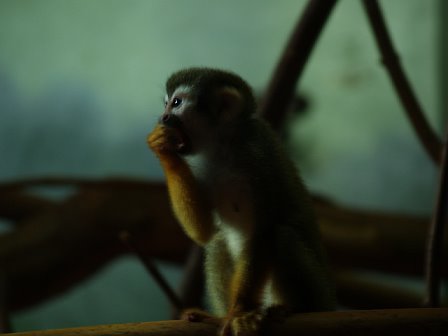
A Squirrel Monkey (Saimiri sp.) enjoying some fruit.
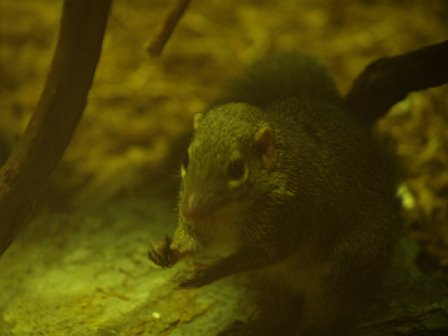
A Tree Shrew (Tupaia sp.), sitting still long enough for me to squeeze off a shot (albeit a blurry one).

One of the Galapagos Tortoise (Geochelone nigra) taking a dip.

A pair of Aardvark (Orycteropus afer) having a snooze in an artificial cave.

“Solstice,” a female White-Handed or Lar Gibbon (Hylobates lar). She shares her habitat with her partner Mercury (who is black rather than blonde) and an Orangutan (Pongo sp.) pair.
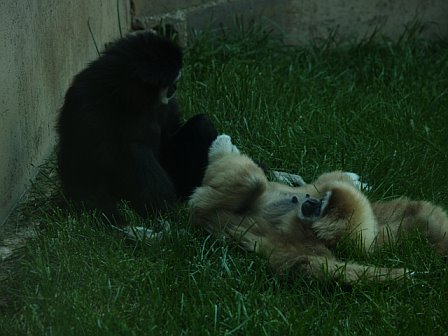
Solstice makes her intentions clear; she wants to be groomed by Mercury.

Mercury seemed more interested in grooming his male orang friend than his partner Solstice.

The male Orang was very shy, and carried a cardboard box on his back like a shell/shade everywhere he went.

And that’s it. Hopefully I’ll soon upload all my photos (there are thousands of them) onto Flickr soon, but I hope that you’ve enjoyed the ones I’ve put up here.
As promised, here is the second set of the better photos from my trip to the Philadelphia Zoo. I probably should (at the reccomendation of several commentors) register with Flickr and upload the lot of them, but that will have to wait until tomorrow (I’ll also go back and do likewise for the pictures on this computer as time permits). Let’s pick up where we left off, with one of my most favorite of big cats, the Amur Leopard (Panthera pardus orientalis);




There is nothing quite so beautiful as the emerald, fiery stare of an Amur Leopard. The eyes of almost any big cat can be described as intense or as being as intricate as a precious stone, but there is something about the gaze of leopards that strikes me in an entirely different way than that of their cousins…

…yet even the most majestic and feline predators needs to make time for a brief tongue-bath every now and again.




It’s amazing the amount of bravado an inch or so of glass can produce. The object of the leopard’s stare was a child that could not have been more than two years old, being held up to the glass by his parents to get a closer look at the “big kitty.”

At times the leopard seemed just as interested in what I was doing as I was in his activities.

It is sad enough that this leopard is among the last of his kind anywhere in the world, being the most endangered of all the big cats. Why he is left on display in isolation, with not even as much as a plaque explaining what species he is and the problem those still in the wild face, not to mention the (as far as I can ascertain) the lack of a breeding/conservation program, confuses and frustrates me.


The Giant River Otter (Pteronura brasiliensis) were also released just as my wife and I reached their enclosure. They certainly seemed excited to be out in their habitat, full of fish for them to snack on.

At one point something apparently spooked the group, and they engaged in a “mobbing” behavior similar to that seen in the BBC’s Planet Earth series when a group of otters of another species faced a Mugger Crocodile. What the disturbance was, I couldn’t tell, but it seemed to come from the other side of their enclosure.
Unfortunately WordPress was a down for a little while last night so I didn’t get to upload the rest of the pictures, but I will do so during a break between my classes in a few hours. Snuggling Aardvarks, primates (from prosimians through apes), and mammalian herbivores of various description.
As promised, here are some of the better shots from yesterday’s visit to the Philadelphia Zoo. I’m sorry to say that I’m going to soon write up something about the Zoo’s shady dealings involving it’s African Elephants (visit Help Philly Zoo Elephants for a spoiler), but for now I’m going to focus on some of the better photos out of the 500+ I shot yesterday. And away we go…

I absolutely love this fountain.

While not particularly exotic, Scottish Highland Cattle are still pretty neat.

A pair of rare Blue-Eyed Lemur, Eulemur macaco flavifrons. The black one is the male, the blonde the female, and they were very excited at the prospect of a snack (the mangabey next door was getting ded fed at the time)

One of my most favorite of all mammals, the Giant Elephant Shrew (Rhynchocyon petersi).

This, by far, was the thinnest Mara (Dolichotis sp.) I think I have ever seen.

The Galapagos Tortoise (Geochelone nigra) were just beginning to stir when we arrived. They weren’t nearly as randy as they had been during our last visit (I thought I had heard it all until I hear the deep tones of tortoise-lovin’)

An African Elephant (Loxodonta africana) that we were told was named “Petunia” was also up and about. The Philly elephants will soon be moved out of their rather meager accomodations, although it might not necessarily be for the better.

This little male Amur Tiger (Panthera tigris altaica) really loved his tire. He wouldn’t let any of his brothers near it without showing his annoyance.
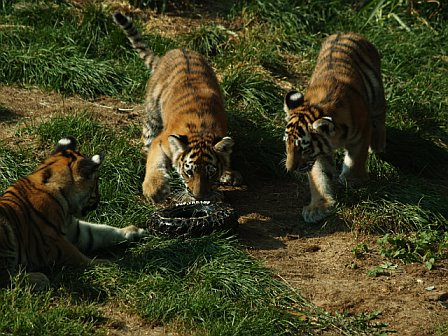



The strangely white female lions were relaxing in the early-morning shade. I know that their condition is a regional variation, although I forget the details at the moment.



Some of my most favorite Carnivores, White-Nosed Coati (Nasua narica) were scrounging for insects and other morsels when we passed by their enclosure.


And, just for Jeremy, a Red Panda (Ailurus fulgens).

We also came across the most evil-looking Caiman I had ever seen (there was no ID plaque, so I’m not sure what species it was).

And the Clouded Leopard (Neofelis nebulosa), as ever, was asleep in it’s hammock. I have never seen this cat move a muscle in my four visits to the Philly Zoo thus far.

Just around the corner, however, was a much more active and curious cat; a male Amur Leopard (Panthera pardus orientalis). He is one of the most beautiful big cats I think I have ever seen, and it’s a shame that he’s essentially “locked up” in his enclosure, and as far as I know the zoo does not keep a female Amur Leopard to run a breeding program for this most critically endangered cat.

I still have at least 25 pictures to share, but you’ll just have to wait a little bit longer for them. Check back later tonight for more of our friend the Amur Leopard, some Giant River Otter, White-Handed Gibbons, and plenty more.
My trip to the Philadelphia Zoo this morning presented lots of great photo ops, especially in the morning. I’ll post more of the plethora (500+) of pictures I took tomorrow, but here’s a bit of a teaser. First, the three male Amur Tiger cubs born recently. The one in the middle really loved his tire;
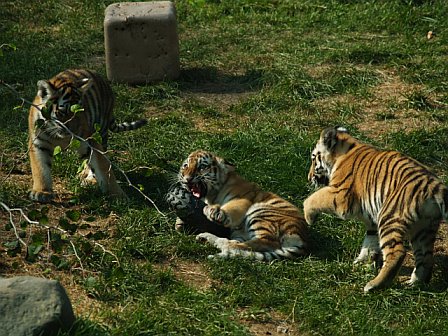
The male Amur Leopard also was very curious about what I was doing on the other side of the glass, being much more active than on previous occasions when I have visited (expect a larger post on Amur Leopards and their plight in the near future);


Replica of the skull of the Hippopotamus, Hippopotamus amphibius, at Disney’s Animal Kingdom Park (via Wikipedia)
Hippos are one of those animals that are sometimes used to drive home the point that appearances can be deceiving; despite their fearsome dentition, they’re really herbivores. They may have bad attitudes and be a terror along African waterways, but at least they’re not carnivorous. At least, that’s the story.

It’s easy to see why the hippopotamus got it’s name, meaning “River Horse.” Taken at the Philadelphia Zoo, August 2006.
While the vast majority of the hippo’s food intake is short grass that grows along river banks, this doesn’t exempt them from eating meat every now and then. In 1996, J.P. Dudley published the paper “Record of carnivory, scavenging and predation for Hippopotamus amphibius in Hwange National Park, Zimbabwe,” followed two years later by “Reports of carnivory by the common hippo Hippopotamus amphibius.” I do not have access to either of these papers, but as far as I understand it, they are the best scientific accounts that we have that hippos do sometimes eat meat. A pdf file announcing the Dudley’s work, states that not only was carnivory witnessed among the hippos, but even cannibalism, the strange habits of the studied group perhaps contributing to an anthrax outbreak that ended up killing 300 hippos in the area.
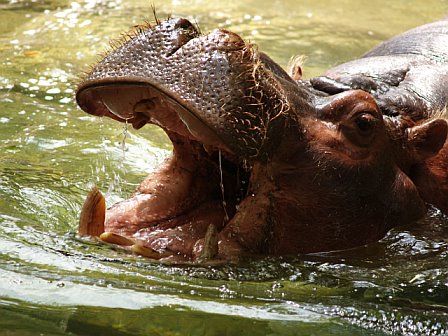
Taken at the Philadelphia Zoo, August 2006.
More clues are offered up by a short summary from a 1999 issue of Natural History;
Although the hippopotamus’s usual fare is this habitual vegetarian can occasionally turn carnivore. Field biologist Joseph P. Dudley, formerly at Hwange National Park in Zimbabwe, observed a male hippo killing an impala ram that had swum through a pond to evade a wild dog. After eating some of the meat, the hippo returned to his herd.
A few minutes Later, ten more individuals from the group gathered at the floating carcass for a communal feast. Later a few of them climbed the pond’s banks to wrest another dead impala from wild dogs. “It seems almost incredible,” writes Dudley, “that carnivorous feeding behavior by hippos, even if of very infrequent occurrence, could have gone unreported for so long.” Perhaps, he opines, the behavior may have been attributable to “nutritional stress caused by severe drought conditions.”

Taken at the Philadelphia Zoo, August 2006.
Even last night I caught a few moments of a nature documentary showing hippos mouthing/playing with bloated carcasses of wildebeest that drowned in an attempt to cross a river during their annual migration between the Serengeti National Park and Masai Mara National Park. The segment was short, but overall it didn’t seem that the hippos were very interested in consuming the dead antelope as much as mouthing it a bit before moving on. Likewise, hippos in captivity have been known to “play” with/harass other animals in their enclosures, especially birds. At Adventure Aquarium in New Jersey, many Turacos ended up dying of stress when they would fall into the hippo enclosure, the mammals taking the birds into their mouths and lashing them about, keepers frantically trying to rescue the birds with a dip net. Darren Naish has also posted anecdotal evidence of carnivory in captive hippos before, as well.
As I said before, I don’t have access to the scientific papers, but it seems that many of the hippo predation/scavenging events occur in years of drought, where large groups of the animals are brought together in one area when grasses and other “normal” foods are scarce. This could be why hippos in the documentary I mentioned above only “mouthed” the carasses of the wildebeest; they may have had plenty of food so there was no need to eat something that’s not a regular part of their diet. Still, as has been mentioned by Dudley, hippos often eat at night, and their nocturnal eating habits have generally kept us in the dark as to what they might be munching on other than grass.
But what about cannibalism and anthrax? A 2004 article in NewScientist suggests that the spread of anthrax in hippos was actually helped by a particularly harsh year where carnivory and cannibalism came apparent. The problem probably started in water contaminated with anthrax or grass containing anthrax spores. The problem with the hypothesis that hippos were initially infected by anthrax-contaminated water, however, is that the park in which the outbreak occurred is said to have plenty of flowing water, not the stagnant pools typical of an environment that harbors anthrax.
Regardless of how it got into the local ecology and transmitted to hippos, however, a particularly harsh or lean year could have easily caused rapid transmission in a population, even if only a small group were infected. If resources were scarce and hippos (known for their aggressiveness) were pushed closer together in the remaining areas of water and food, there would be much more fighting, and hippos leave tremendous gashes (prone to infections) on each other during these fights. This would make the animals more susceptible to infection, and because hippos appear to eat meat more when other food is scarce, the infected hippos would be more likely to be consumed, infecting even more hippos and leading to a runaway outbreak.

Looking at the dentition of hippos, part of the reason why I wouldn’t necessarily expect carnivory to be common is that their teeth seem to be more adapted to be weapons than efficient cutting/slicing teeth. Hippos may have a good amount of power behind their bite, and the teeth in the front of their jaw are certainly powerful when it comes to puncturing, but it would seem to me that they would have to puncture carcasses with their massive front teeth and then try to rip off bits to then swallow whole; they lack the more efficient piercing and cutting teeth of carnivores like dogs and big cats. The apparently get by well enough without it when times get hard, but it doesn’t seem like they’re particularly well-adapted to carnivory. The following clip gives us a brief glimpse of a hippo scavenging from a buffalo carcass, although it doesn’t seem particularly interested in consuming much or fighting the lions for the carcass;
While it may be easy to write off such behaviors as aberrant or abnormal, they are very important to our understanding of ecology. Many people have a somewhat Disney-esque idea of what nature is like, with the “great Circle of Life” allowing each animal to have their own niche and live in harmony with each other; carnivores only eat other animals, herbivores only eat plants, and mammalian babies are cared for by both the “mommy and daddy” until they grow up. The truth of the matter is that ecological interactions are far more complex than we realize, sometimes revealing a “darker” side of nature than some people care to acknowledge (but again, this is putting a moral judgment on nature, which does not operate by a moral code or “Law of the Jungle”). There is cooperation in nature, but there is also fierce competition, and when ecologies start to become strained, whole new dimensions of behavior that are otherwise hidden or only barely visible come into play in an attempt to allow for the survival of the individual animal. Why should we expect otherwise?

Hippo Skeleton. Via Wikipedia.

I originally posted this photo last January, way back when I had all of two readers, so I thought I would bring it back up front. This is one of the cougars at the Philadelphia Zoo’s “Big Cat Falls” exhibit, and the three cougars in the exhibit seem to love to hang out right in front of the glass. If you can get there early on a cold day when the glare isn’t so bad, the photo opportunities can be fantastic.

Taken at the Bronx Zoo in December, 2006
Before I switched themes, this photo was the basis for the header above the website, and even though I changed by banner in favor of Charles R. Knight’s leapin’ Laelaps (excuse me, Dryptosaurus), I still find love the above photo. Most days that I visit the zoo the Red Pandas are sleeping, heads tucked in under their bushy tails. On this particular trip, however, they were especially active, and this one was curious enough to let me get some decent close-ups.

Zeff, a 13-year-old Amur (Siberian) Tiger at the Bronx Zoo (Taken February 2007)
A zoo in Romania is now home to two new tiger cubs, Lenuta and Costel, and it appears that their mother is caring for them. This story reminded me that the Philadelphia Zoo recently had some luck with its tiger-breeding program as well, with three tiger cubs being born this past spring as well (you can read more at the zoo’s official blog).

Rasi, one of the cheetah trio at the Philadelphia Zoo (taken January 2007)
There may be some cheetah cubs on the way at the zoo soon too, the brothers Micah, Rasi, and Spidi getting some female companionship in the near future. I haven’t been back to the Philly Zoo since February so I don’t know if the female has arrived or picked her mate yet, but I’ll definitely keep my eyes open for any news.

Yesterday, my wife and I left at 3 AM to arrive at the most southern point/beach in New Jersey, arriving just after the sun began to rise.

And here is my lovely wife in the early morning light;

We also encountered some local wildlife before even setting foot on the beach or pathways along the dunes. Many birds rested in their large birdhouses, and a small toad sat on the bench outside the restrooms;



Once we set foot on the beach, there were already plenty of Laughing Gulls skittering about on the sand and trying to snatch some bait from early-bird fishermen;

Tracey and I also noted a strange blob bobbing about in the surf. It turned out to be a dead jellyfish;

We saw many more of the decomposing cnidarians on the beach that morning;

After taking a little snooze on the beach, we took a short walk on a path behind the dunes, watching an immature Great Blue Heron and an egret try to catch their breakfast;


Small rabbits also abounded along the shore, and we saw many over the course of the day;

Being that it was too early to head over to the docks for our whale watching tour, we stopped by the Nature Conservancy migratory bird refuge. While most of the birds were too far away or simply not present during our visit, I did spot a number of Red-Winged Blackbirds, and this particular fellow was especially robust and colorful;

This bright flower also caught our eye;

By the time was had walked the trail it was time for our cruise, although nothing much happened for the first hour or so (outside of being followed by some laughing gulls);

The whole trip did not turn out to be a wash, however, as we came across a rather large pod of Bottlenose Dolphins (15-20 individuals) feeding close to shore, right in front of one of John Wyland’s famous “Whaling Walls” (depicting a Humpback Whale, amongst other marine life);


After the overall mediocre cruise and stopping for lunch, we headed to the Cape May Zoo, where I finally got to see some live Pronghorns (previously the only ones I had seen were the stuffed ones at the AMNH);


And, of course, no zoo trip would be complete without seeing a Muntjac;
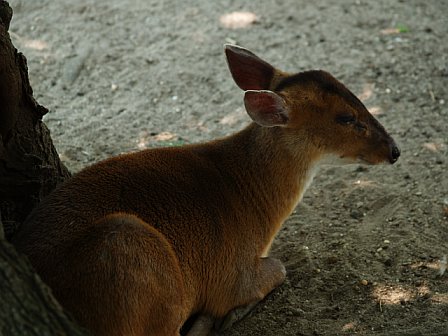

While I had seen Capybara in zoos before, I at long last got to see one swimming, as well;
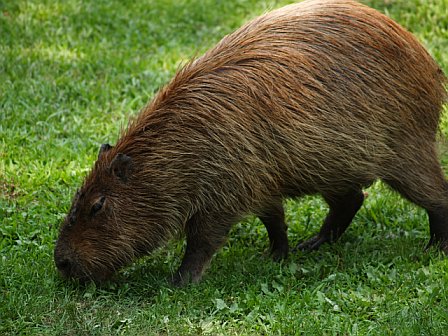

As would be expected, the American Alligators were also cooling off in the water, albeit in a more stagnant pool;

The weather was rather hot, so the big cats (lion, cheetah, tiger) mostly stayed out of the sun (and therefore impossible to photograph). I did manage to get a few shots of the leopard and ocelot, however;
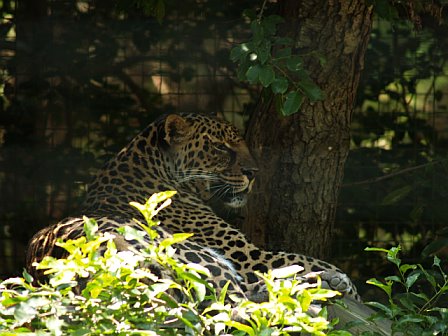
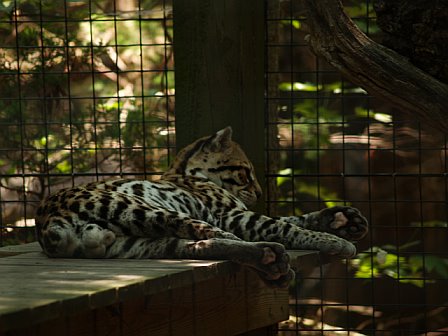
The animals in the African plains enclosures were a bit more active, however, including the Reticulated Giraffes and Grey’s Zebra (previously I had only seen Grevy’s Zebras);


While not as exotic, the raccoons and swift fox the zoo kept provided me with some decent shots as well;
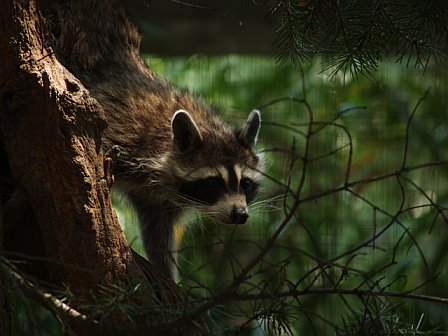

Before leaving, we also stopped into the “World of Birds,” where I encountered this strange species with yellow waddles (and showed no fear or concern that I was photographing it from so close a range);


Not long afterwards, we ate our dinner and headed for home, overall being a good day in Cape May. I also wanted to include this picture of a deer I got a few weeks ago in Pennington, NJ, where I was petsitting;

Recent Comments